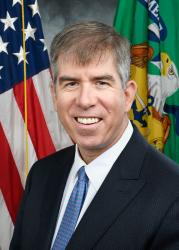Who are the millions of people living in poverty in the United States?
In 2016, 40.6 million people, or 12.7 percent of the population, lived in poverty, as defined by the official poverty measure. 6 million fewer people were living in poverty in 2016 than at the peak of 46.7 million in 2014. The official poverty measure is determined by a household’s pre-tax income; for example, in 2016, a family of four earning less than $24,339 would be considered poor.
From 1980 to 2014, the number of people living in poverty in the United States grew from about 29.3 million to 46.7 million. Over this same period, the pre-tax income of the bottom quintile of earnings grew 4 percent while incomes of the top 1 percent grew 194 percent. From 1980 to 2016, growth in the number of people in poverty has come largely from working-age adults.
In this economic analysis, we characterize those who were living in poverty in 2016, as we reported for 2014 and 2015. We then extend these snapshots to examine the population living in poverty over time: how have the characteristics of those living in poverty changed over the past 30 years? We focus particularly on the working-age poor. What share of the working-age poor are in the labor force? What are the most prevalent reasons for labor force nonparticipation among the working-age poor? For those who are working part-time and poor, is it involuntary or for reasons specific to their circumstances?
Characterizing Poverty in the United States
Each September, the U.S. Census Bureau releases a report on the official rate of poverty in the United States for the previous year. Calculated from the Current Population Survey Annual Social and Economic Supplement (ASEC), a family is considered to be officially in poverty if their pre-tax income is below a threshold set by the current value of three times a minimum food diet in 1963, adjusted by family composition.
Using these same data, released by IPUMS, we characterize those living below the official poverty line in the United States. After identifying children and senior citizens in poverty, we look at working-age (18- to 64-year-olds) poverty. We use additional questions in the ASEC to characterize those of working-age as labor force participants (working full- or part-time or seeking work). If respondents were labor force nonparticipants, we then classified them as students, caregivers, disabled, early retirees, or labor force nonparticipants who defy classification into one of those categories. These were mutually exclusive categories and were assigned in descending order: labor force participant, student, disabled, caregiver, and early retiree; for example, if a working-age person in poverty is a student and labor force participant, they were categorized as a labor force participant.1
In 2016, one-third of those living in poverty were children under the age of 18 and 11 percent were senior citizens over the age of 65 (figure 1). The remaining 56 percent of those living in poverty were of working age (18 to 64). One quarter of all those living in poverty were in the labor force and an additional 3 percent were early retirees. An additional 12 percent of the total were of working-age and disabled. Another 15 percent of those living in poverty were working-age adults who were students or caregivers, while just 2 percentage points of those living in poverty defied classification.

How has the population living below the official poverty line changed in the past 30 years?
There were approximately 13.3 million children in poverty in 2016, 3 million fewer children than at the thirty-year peak in 2010. Children made up a smaller share of those in poverty in 2016 compared with every previous year since 1986. In 2016, 18 percent of children were in poverty, 2 percent points below the thirty-year average of 20 percent.
Senior citizens are decreasingly likely to be in poverty—9 percent of seniors were in poverty in 2016 compared to 12 percent in 1986—but due to population growth and aging, there are more poor seniors today. Senior citizens now make up a larger share of those in poverty than they have in over 30 years and the number of seniors in poverty was the second highest behind 2014 at 4.6 million. The number of seniors in poverty has continued to increase even as the total number of those in poverty has declined.
As seen in figure 2, growth in the number of people living in poverty has largely come from working-age adults. Over the past 30 years, a growing number of working-age people were poor (from 16 million in 1986 to 22.8 million in 2016). Since 1993, more than half of those living in poverty have been of working-age with the 2016 share (56.1 percent) just slightly below the peak (57.3 percent in 2011).

The official poverty measure is imperfect, but is valuable as a consistent benchmark for tracking poverty over time and is relevant because it determines eligibility for some programs. There are two other prominent measures of poverty: the supplemental poverty measure and the consumption measure, which differ from the official poverty measure on every dimension. The supplemental poverty threshold is based on expenditures on food, clothing, shelter, and utilities, and is geographically adjusted. While the official poverty measure only counts pre-tax income as the resources available to a family, the supplemental poverty measure additionally counts refunded taxes and noncash benefits that can be used for food, cloth, shelter, and utilities, like SNAP benefits. A third way to measure poverty is by consumption: if a family were to consume less than an adjusted poverty threshold, excluding certain expenditures, they would be considered poor. Both the consumption measure and the supplemental measure are improvements on the official poverty measure because they address whether tax and transfer policies and programs affect poverty.
Using data from 2015, the most recent year for which we have data on all measurements, we look at how the analysis differs between the three measures.
In figure 3, we compare the characteristics of individuals living in poverty by the official against the supplemental poverty measure (SPM) for 2015, the most recent year of available data for both. Acknowledging that survey respondents underreport benefit receipt, this SPM is likely to overstate the number in poverty. Nevertheless, there were almost three million fewer children in poverty by the SPM than by the official poverty measure in 2015. (For a complete treatment of the status and trends of children in poverty, see a recent report by Isaac Shapiro and Danilo Trisi at the Center on Budget and Policy Priorities.) There were more working-age adults and senior citizens in poverty by the SPM than the official poverty measure in 2015.

While we cannot reproduce the working-age classifications as we report in figure 3 for the consumption measure, Bruce Meyer and James Sullivan report rates of consumption poverty in the same age-based categories as ours. By their calculation, rates of consumption poverty in 2015 were 5.2 percent for children under 18, 3.1 percent for working-age adults 18 to 64, and 1.8 percent for senior citizens. By the official poverty measure in 2015, 20 percent of children, 12 percent of working-age adults, and 9 percent of seniors were poor in 2015. By the supplemental poverty measure, 16 percent of children, 14 percent of working-age adults, and 14 percent of seniors were poor in 2015.
Trends in the Characteristics of the Working-Age Poor
Returning to the official poverty measure, we take a deeper look at the characteristics of the working-age poor. The working-age poor are a diverse group (figure 4). More than 40 percent of the working-age poor were working or actively seeking work in 2016. The largest group of working-age adults living in poverty were employees working less than full-time and full-year: 28 percent. These workers could be working full-time for part of the year, part-time for the full year, or some combination of the two. One in ten working-age adults living in poverty is working full-time full-year. 4 percent of working-age adults living in poverty were unemployed and seeking work.
As discussed in greater depth in previous Hamilton Project work, over half of working-age adults living in poverty were labor force nonparticipants. Using self-reported responses to other questions on the ASEC, we characterize labor force nonparticipants living in poverty by their stated reasons for nonparticipation. In 2016, 20 percent of working-age adults living in poverty reported being disabled, 15 percent reported being caregivers, 13 percent reported being students, and 6 percent reported being early retirees. Only 4 percent of working-age adults were labor force nonparticipants who were not disabled, caregivers, students, or early retirees.

Over the past 30 years, a growing share of working-age adults in poverty have been labor force nonparticipants, rising from 42 percent in 1986 to 58 percent in 2016. These increases have been driven primarily by larger numbers of those with a disability, as well as by students in poverty, and to a lesser extent by early retirees. While the number of working-age students living in poverty increased dramatically with the onset of the Great Recession, the other labor force nonparticipant classifications have been steadily increasing over a longer time period. The number of disabled working-age adults in poverty has increased nearly every year, rising from a 10.9 percent share of the working-age poor in 1986 to a 20.5 percent share in 2016.
In contrast, the increase in students in poverty has been a more recent phenomenon. A worsening labor market during the recession may have lowered the opportunity cost of attending school, encouraging people without jobs to enter degree programs. The American Recovery and Reinvestment Act of 2009 increased the generosity of Pell Grants and introduced new postsecondary education tax benefits. Furthermore, as Sarah Turner documented in a Hamilton Project policy proposal, the Departments of Education and Labor sent a guidance letter to states which informed them that unemployment insurance recipients were eligible for Pell Grants, in turn increasing postsecondary enrollment. But, as shown in figure 5, the number of students who are poor has stayed large during the recovery, possibly reflecting a declining share of students who work while in school. Some students may have other resources, from parents or loans, to support themselves while in school, while others may face material wants.

Not surprisingly, the share of labor force participants living in poverty increased overall during the Great Recession, though the number in poverty who were working full-time decreased as part-time work and unemployment increased. As the unemployment rate doubled, a much larger share of those in poverty were actively seeking employment (rising from 3.2 percent in 2006 to 8.3 percent in 2010). In 2010, at the peak of both unemployment and involuntary part-time work, 2.2 million working-age adults were unemployed and living in poverty and 7.9 million were working part-time and living in poverty. In 2016, 850,000 working-age adults were unemployed and living in poverty and 6.3 million were working part-time and living in poverty.
Why Do Some Living in Poverty Work Only Part-time?
Figure 6 describes the reasons given by adults living in poverty for working part-time in the past week (as of March 2017). This is a different population than those who worked less than full-time year-round in 2016 (figures 4 and 5). In 2016 there were 6.3 million workers who worked less than full-time year-round. In March 2017 there were 3 million who reported working part-time in the previous week. Looking at why part-time workers were working part-time is of particular interest because working more hours would help to lift many of these workers out of poverty.

Critically, one in three of these workers was working part-time involuntarily. This is the group most likely to be helped by a strengthening economy. Other groups report an inability to work full-time for a variety of reasons specific to their circumstances. Almost a quarter of part-time workers living in poverty were working part-time because of caregiving responsibilities. One-fifth of part-time workers living in poverty were working part-time while going to school. Five percent of part-time workers living in poverty were disabled and 2 percent were early retirees.
In the past 20 years, growth in the number of part-time workers has been driven both by cyclical factors and other trends.
Among the working-age poor, involuntary part-time work spiked during the Great Recession, growing from approximately 950,000 in 2008 to 2 million in 2010. By 2016, this figure had dropped to 980,000 (with 400,000 of that decline coming between 2015 and 2016). Those who were working part-time and living in poverty due to caregiving responsibilities were the only group that grew in number from 2016 to 2017, from approximately 630,000 to 690,000.

Conclusion
To craft effective policies to combat poverty, it is critical to understand the various challenges faced by people living in poverty, and how these challenges have evolved over time.
The decline in the share of children in poverty is a welcome development, but children still represent a large share of those in poverty, and alternative measures of poverty also show millions of children in poverty. Looking forward, population aging will likely lead more seniors to slip into poverty, even if the share of seniors who are poor continues to fall. As this trend continues, reforms to some senior support policies will be needed to ensure that seniors in poverty do not become increasingly commonplace.
A stronger job market that provides more full-time opportunities would be helpful across the board, particularly for those living in poverty who are unemployed or are working part-time involuntarily. This is an important reminder that even in a stronger economy, those struggling to find work cannot work their way out of poverty when poverty is defined in part by pre-tax income.
On the opposite end of the spectrum are those who have a full-time job, but still live in poverty. Over 2 million Americans meet this criteria: working full-time all year long but not earning enough to work their way out of poverty. Rising wages are needed to lift these individuals out of poverty.
Conversely, for the nearly six in ten working-age adults who are in poverty and are not in the labor force, changes in wages or hours will likely not move people out of poverty. Whether people are out of the labor force due to disability, being a caregiver, or a student, more targeted interventions beyond the labor market are likely necessary to substantially reduce the number of Americans in poverty.
-
Footnotes
- For a complete accounting of the categorization rules, please review the technical appendix.
The Brookings Institution is committed to quality, independence, and impact.
We are supported by a diverse array of funders. In line with our values and policies, each Brookings publication represents the sole views of its author(s).






